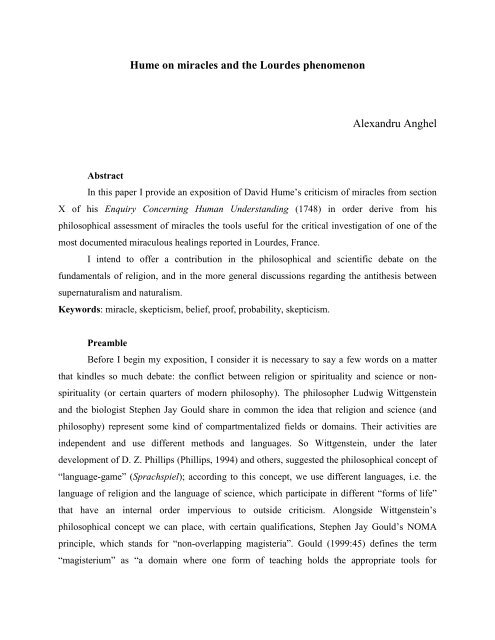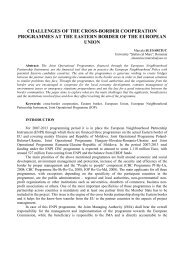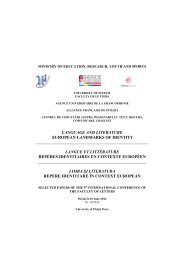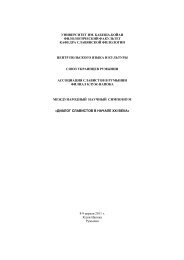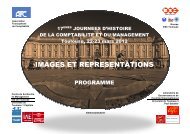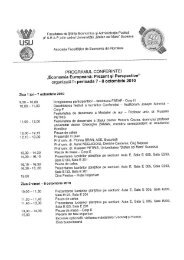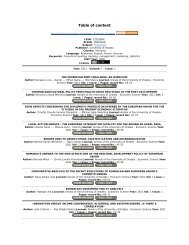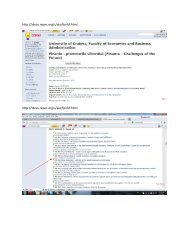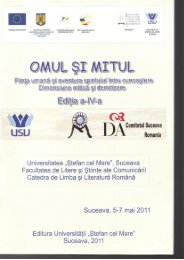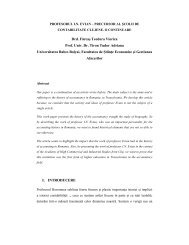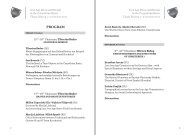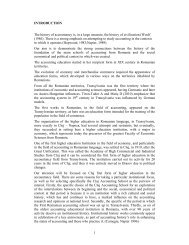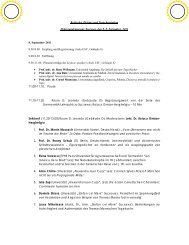Hume on miracles and the Lourdes phenomenon Alexandru Anghel
Hume on miracles and the Lourdes phenomenon Alexandru Anghel
Hume on miracles and the Lourdes phenomenon Alexandru Anghel
Create successful ePaper yourself
Turn your PDF publications into a flip-book with our unique Google optimized e-Paper software.
Abstract<br />
<str<strong>on</strong>g>Hume</str<strong>on</strong>g> <strong>on</strong> <strong>miracles</strong> <strong>and</strong> <strong>the</strong> <strong>Lourdes</strong> phenomen<strong>on</strong><br />
Alex<strong>and</strong>ru <strong>Anghel</strong><br />
In this paper I provide an expositi<strong>on</strong> of David <str<strong>on</strong>g>Hume</str<strong>on</strong>g>’s criticism of <strong>miracles</strong> from secti<strong>on</strong><br />
X of his Enquiry C<strong>on</strong>cerning Human Underst<strong>and</strong>ing (1748) in order derive from his<br />
philosophical assessment of <strong>miracles</strong> <strong>the</strong> tools useful for <strong>the</strong> critical investigati<strong>on</strong> of <strong>on</strong>e of <strong>the</strong><br />
most documented miraculous healings reported in <strong>Lourdes</strong>, France.<br />
I intend to offer a c<strong>on</strong>tributi<strong>on</strong> in <strong>the</strong> philosophical <strong>and</strong> scientific debate <strong>on</strong> <strong>the</strong><br />
fundamentals of religi<strong>on</strong>, <strong>and</strong> in <strong>the</strong> more general discussi<strong>on</strong>s regarding <strong>the</strong> anti<strong>the</strong>sis between<br />
supernaturalism <strong>and</strong> naturalism.<br />
Keywords: miracle, skepticism, belief, proof, probability, skepticism.<br />
Preamble<br />
Before I begin my expositi<strong>on</strong>, I c<strong>on</strong>sider it is necessary to say a few words <strong>on</strong> a matter<br />
that kindles so much debate: <strong>the</strong> c<strong>on</strong>flict between religi<strong>on</strong> or spirituality <strong>and</strong> science or n<strong>on</strong>-<br />
spirituality (or certain quarters of modern philosophy). The philosopher Ludwig Wittgenstein<br />
<strong>and</strong> <strong>the</strong> biologist Stephen Jay Gould share in comm<strong>on</strong> <strong>the</strong> idea that religi<strong>on</strong> <strong>and</strong> science (<strong>and</strong><br />
philosophy) represent some kind of compartmentalized fields or domains. Their activities are<br />
independent <strong>and</strong> use different methods <strong>and</strong> languages. So Wittgenstein, under <strong>the</strong> later<br />
development of D. Z. Phillips (Phillips, 1994) <strong>and</strong> o<strong>the</strong>rs, suggested <strong>the</strong> philosophical c<strong>on</strong>cept of<br />
“language-game” (Sprachspiel); according to this c<strong>on</strong>cept, we use different languages, i.e. <strong>the</strong><br />
language of religi<strong>on</strong> <strong>and</strong> <strong>the</strong> language of science, which participate in different “forms of life”<br />
that have an internal order impervious to outside criticism. Al<strong>on</strong>gside Wittgenstein’s<br />
philosophical c<strong>on</strong>cept we can place, with certain qualificati<strong>on</strong>s, Stephen Jay Gould’s NOMA<br />
principle, which st<strong>and</strong>s for “n<strong>on</strong>-overlapping magisteria”. Gould (1999:45) defines <strong>the</strong> term<br />
“magisterium” as “a domain where <strong>on</strong>e form of teaching holds <strong>the</strong> appropriate tools for
meaningful discourse <strong>and</strong> resoluti<strong>on</strong>", <strong>and</strong> c<strong>on</strong>cerning <strong>the</strong> NOMA principle, “<strong>the</strong> magisterium of<br />
science covers <strong>the</strong> empirical realm: what <strong>the</strong> Universe is made of (fact) <strong>and</strong> why does it work in<br />
this way (<strong>the</strong>ory). The magisterium of religi<strong>on</strong> extends over questi<strong>on</strong>s of ultimate meaning <strong>and</strong><br />
moral value. These two magisteria do not overlap, nor do <strong>the</strong>y encompass all inquiry (c<strong>on</strong>sider,<br />
for example, <strong>the</strong> magisterium of art <strong>and</strong> <strong>the</strong> meaning of beauty).”<br />
These philosophical <strong>and</strong> methodological positi<strong>on</strong>s are, in my opini<strong>on</strong>, mistaken, <strong>and</strong>, for<br />
<strong>the</strong>m to work, you have to disregard or to minimize a very important aspect of religi<strong>on</strong>: its<br />
cosmological claims. Yes, religi<strong>on</strong>, like science, has a lot to say about <strong>the</strong> origin of <strong>the</strong> world <strong>and</strong><br />
<strong>the</strong> appearance of man, about morality, about <strong>the</strong> origin <strong>and</strong> workings of phenomena… about<br />
“<strong>miracles</strong>”. Science <strong>and</strong> religi<strong>on</strong> are two (most of <strong>the</strong> time c<strong>on</strong>flicting) kinds of explanati<strong>on</strong><br />
about <strong>the</strong> world; <strong>the</strong>ir methods differ in many respects <strong>and</strong> <strong>the</strong> outcome of <strong>on</strong>e proves sometimes<br />
damaging to <strong>the</strong> o<strong>the</strong>r. 1<br />
My scope in this paper is to critically discuss a very cherished <strong>and</strong> very c<strong>on</strong>troversial <strong>and</strong><br />
ambiguous element in religi<strong>on</strong> in particular <strong>and</strong> spirituality in general: <strong>the</strong> miracle. I will discuss<br />
a case that is closer to our days in comparis<strong>on</strong>, for example, with <strong>the</strong> New Testament reports of<br />
<strong>miracles</strong>. For my assessment I will use David <str<strong>on</strong>g>Hume</str<strong>on</strong>g>’s evaluati<strong>on</strong> of miracle reports <strong>and</strong><br />
reliability of witness, taken from his (skeptical) philosophy of religi<strong>on</strong>, in order to observe in<br />
what degree <str<strong>on</strong>g>Hume</str<strong>on</strong>g>’s arguments are tenable. I will also take into c<strong>on</strong>siderati<strong>on</strong> some<br />
c<strong>on</strong>temporary philosophical <strong>and</strong> scientific investigati<strong>on</strong>s that can be applied to <strong>the</strong> case in<br />
questi<strong>on</strong> in order to complement or update certain aspects of <str<strong>on</strong>g>Hume</str<strong>on</strong>g>’s evaluati<strong>on</strong>.<br />
The article is divided in three secti<strong>on</strong>s. In <strong>the</strong> first secti<strong>on</strong> I will talk about <strong>the</strong> idea of<br />
miracle <strong>and</strong> what it means in religi<strong>on</strong> <strong>and</strong> in philosophy in general <strong>and</strong> about <str<strong>on</strong>g>Hume</str<strong>on</strong>g>’s<br />
interpretati<strong>on</strong> of <strong>miracles</strong> in particular. In <strong>the</strong> sec<strong>on</strong>d I will present what I call <strong>the</strong> <strong>Lourdes</strong><br />
phenomen<strong>on</strong>, <strong>on</strong>e of <strong>the</strong> places of pilgrimage in <strong>the</strong> Christian world where, every year, <strong>the</strong>re are<br />
reported new <strong>miracles</strong> performed by <strong>the</strong> Virgin Mary. In <strong>the</strong> last secti<strong>on</strong> I will assess <strong>the</strong> <strong>Lourdes</strong><br />
phenomen<strong>on</strong> using <str<strong>on</strong>g>Hume</str<strong>on</strong>g>’s critical methods presented in <strong>the</strong> sec<strong>on</strong>d secti<strong>on</strong>.<br />
1. <str<strong>on</strong>g>Hume</str<strong>on</strong>g> <strong>on</strong> <strong>miracles</strong><br />
1 By now, science proved to have a corrosive effect <strong>on</strong> religi<strong>on</strong>, <strong>the</strong> latter changing some of its claims about <strong>the</strong><br />
universe, <strong>the</strong> most notorious <strong>on</strong>e being <strong>the</strong> shift from <strong>the</strong> Ptolemaic earth-centered to <strong>the</strong> Copernican sun-centered<br />
planetary system.
The Oxford English Dicti<strong>on</strong>ary defines <strong>the</strong> word “miracle” as follows: “A marvelous<br />
event occurring within human experience, which cannot have been brought about by human<br />
power or by <strong>the</strong> operati<strong>on</strong> of any natural agency, <strong>and</strong> must <strong>the</strong>refore be ascribed to <strong>the</strong> special<br />
interventi<strong>on</strong> of <strong>the</strong> Deity or of some supernatural being; chiefly, an act (e.g. of healing)<br />
exhibiting c<strong>on</strong>trol over <strong>the</strong> laws of nature, <strong>and</strong> serving as evidence that <strong>the</strong> agent is ei<strong>the</strong>r divine<br />
or is specially favoured by God.” (OED, 1989; italics added) Ano<strong>the</strong>r dicti<strong>on</strong>ary, form <str<strong>on</strong>g>Hume</str<strong>on</strong>g>’s<br />
period, compiled by N. Bailey states <strong>the</strong> following about <strong>the</strong> word “<strong>miracles</strong>”: “Works effected<br />
in a manner unusual or different from <strong>the</strong> comm<strong>on</strong> <strong>and</strong> regular method of <strong>the</strong> Almighty<br />
Providence, by <strong>the</strong> Interpositi<strong>on</strong> ei<strong>the</strong>r of himself or of some intelligent Agent, superior to Man,<br />
for <strong>the</strong> Evidence <strong>and</strong> proving of some particular Doctrine, or in Attestati<strong>on</strong> to <strong>the</strong> Authority of<br />
some particular Pers<strong>on</strong> or Pers<strong>on</strong>s.” (Bailey, 1730; italics added) I chose <strong>the</strong>se two definiti<strong>on</strong>s,<br />
<strong>on</strong>e from <strong>the</strong> eighteen century <strong>and</strong> <strong>the</strong> o<strong>the</strong>r from our time, to point <strong>the</strong> similarities <strong>and</strong> <strong>the</strong><br />
dissimilarities between <strong>the</strong> two approaches. As it can be seen, in c<strong>on</strong>trast to <strong>the</strong> Oxford<br />
definiti<strong>on</strong>, Bailey says that a miracle is “unusual or different from <strong>the</strong> comm<strong>on</strong> <strong>and</strong> regular<br />
method of <strong>the</strong> Almighty Providence”. This statement is a reflecti<strong>on</strong> of <strong>the</strong> thinking <strong>and</strong> <strong>the</strong><br />
debates happening in his period, between deists <strong>and</strong> fidests or between reas<strong>on</strong> (natural religi<strong>on</strong>)<br />
<strong>and</strong> faith. As J. M. Suderman observes, “Eighteenth-century miracle definiti<strong>on</strong>s included three<br />
comm<strong>on</strong> but distinct elements: (1) reference to an event c<strong>on</strong>trary to <strong>the</strong> ordinary course of nature,<br />
<strong>and</strong> (2) ascripti<strong>on</strong> of agency to some supernatural power, (3) for <strong>the</strong> purpose of proving a divine<br />
truth or favor.” (Suderman, 2001:129) As it will be seen, <str<strong>on</strong>g>Hume</str<strong>on</strong>g> placed his emphasis up<strong>on</strong> <strong>the</strong><br />
first element, which c<strong>on</strong>stitutes <strong>the</strong> exact aspect of <strong>the</strong> definiti<strong>on</strong> observable in experience.<br />
<str<strong>on</strong>g>Hume</str<strong>on</strong>g>’s critique of <strong>miracles</strong> is mainly c<strong>on</strong>centrated in secti<strong>on</strong> X of his Enquiry<br />
C<strong>on</strong>cerning Human Underst<strong>and</strong>ing ([1748]2007). His argument is divided into two secti<strong>on</strong>s or<br />
stages. (a) In <strong>the</strong> first, he discusses <strong>the</strong> c<strong>on</strong>diti<strong>on</strong>s that a report about a miracle should meet in<br />
order to be accepted by a pers<strong>on</strong> who “proporti<strong>on</strong>s his belief to <strong>the</strong> evidence” (2007:110). (b) In<br />
<strong>the</strong> sec<strong>on</strong>d stage, he examines whe<strong>the</strong>r <strong>the</strong> testim<strong>on</strong>y for presumed <strong>miracles</strong>, in fact, fulfill <strong>the</strong><br />
c<strong>on</strong>diti<strong>on</strong>s expressed in <strong>the</strong> first stage, this fulfillment making <strong>the</strong> testim<strong>on</strong>y a kind of evidence<br />
for <strong>the</strong> truth of religi<strong>on</strong> 2 .<br />
2 Some scholars (Paluch 1966-1967 <strong>and</strong> Mckinn<strong>on</strong> 1967) c<strong>on</strong>cluded that <str<strong>on</strong>g>Hume</str<strong>on</strong>g>, in c<strong>on</strong>sidering that <strong>miracles</strong> are<br />
“violati<strong>on</strong>s of <strong>the</strong> laws of nature”, did not believe that <strong>miracles</strong> are, in principle, possible. This c<strong>on</strong>clusi<strong>on</strong> is<br />
supported by <strong>the</strong> idea that <str<strong>on</strong>g>Hume</str<strong>on</strong>g> didn’t believe that <strong>the</strong> laws of nature can be broken <strong>and</strong> <strong>on</strong> passages such as this:
eas<strong>on</strong>ing:<br />
(a) <str<strong>on</strong>g>Hume</str<strong>on</strong>g> begins his argument by a cauti<strong>on</strong>ary remark c<strong>on</strong>sidering <strong>the</strong> fallibility of causal<br />
Though experience be our <strong>on</strong>ly guide in reas<strong>on</strong>ing c<strong>on</strong>cerning matters of fact; it must be<br />
acknowledged, that this guide is not altoge<strong>the</strong>r infallible, but in some cases is apt to lead us into<br />
errors. . . . All effects follow not with like certainty from <strong>the</strong>ir supposed causes. Some events are<br />
found, in all countries <strong>and</strong> all ages, to have been c<strong>on</strong>stantly c<strong>on</strong>joined toge<strong>the</strong>r: O<strong>the</strong>rs are<br />
found to have been more variable, <strong>and</strong> sometimes to disappoint our expectati<strong>on</strong>s; so that, in our<br />
reas<strong>on</strong>ings c<strong>on</strong>cerning matter of fact, <strong>the</strong>re are all imaginable degrees of assurance, from <strong>the</strong><br />
highest certainty to <strong>the</strong> lowest species of moral evidence (<str<strong>on</strong>g>Hume</str<strong>on</strong>g>, [1748]2007:110).<br />
The “degrees o assurance” menti<strong>on</strong>ed by <str<strong>on</strong>g>Hume</str<strong>on</strong>g> in this passage refer to events in our<br />
experience that have a higher or <strong>the</strong> highest degree of certainty, for example <strong>the</strong> fact that <strong>the</strong><br />
chair I sat <strong>on</strong> a few minutes ago will not break down if I sit <strong>on</strong> it now (an event with a high<br />
degree of probability) <strong>and</strong> <strong>the</strong> fact that sun will rise tomorrow morning (an event with <strong>the</strong> highest<br />
degree of probability); <strong>and</strong> events which “represent <strong>the</strong> lowest species of moral evidence”, moral<br />
evidence referring here to undetectable human motivati<strong>on</strong>s. The latter category comprehends<br />
different testim<strong>on</strong>ies <strong>and</strong> <strong>the</strong> kind of experience that is c<strong>on</strong>trary to <strong>the</strong> order of things observed,<br />
for example <strong>the</strong> sightings of an UFO.<br />
So, for <str<strong>on</strong>g>Hume</str<strong>on</strong>g> <strong>the</strong>re is no absolute certainty that <strong>the</strong> chair will not broke down or even that<br />
<strong>the</strong> sun will rise tomorrow. There is no rati<strong>on</strong>al guarantee that <strong>the</strong> world as we know it now will<br />
be <strong>the</strong> same way in <strong>the</strong> next minute. All our beliefs about our mind, our body <strong>and</strong> <strong>the</strong> world are<br />
based <strong>on</strong> past experience, our own past experience – though this last idea in not quite exact,<br />
c<strong>on</strong>sidering <strong>the</strong> fact that not all our underst<strong>and</strong>ing of <strong>the</strong> world is derived <strong>on</strong>ly from our<br />
experience: we learn also form <strong>the</strong> experiences of o<strong>the</strong>rs (for example, if we didn’t learn from<br />
“And what have we to oppose to such a cloud of witnesses, but <strong>the</strong> absolute impossibility or miraculous nature of<br />
<strong>the</strong> events, which <strong>the</strong>y relate? And this surely, in <strong>the</strong> eyes of all reas<strong>on</strong>able people, will al<strong>on</strong>e be regarded as a<br />
sufficient refutati<strong>on</strong>.” (<str<strong>on</strong>g>Hume</str<strong>on</strong>g>, [1748]2007: 125) According to this interpretati<strong>on</strong>, we must ei<strong>the</strong>r discard <strong>the</strong> law <strong>and</strong><br />
admit that such a law of nature is inexistent since it was falsified, or reformulate it to include <strong>the</strong> new facts<br />
discovered. Or we could simply deny <strong>the</strong> possibility of <strong>the</strong> alleged miracle (see Flew 1961:186-187, 200-209). This<br />
interpretati<strong>on</strong> totally discards <str<strong>on</strong>g>Hume</str<strong>on</strong>g>’s enterprise in secti<strong>on</strong> X of his Enquiry C<strong>on</strong>cerning Human Underst<strong>and</strong>ing, in<br />
which, as we shall see, he tries to probe <strong>and</strong> asses <strong>the</strong> trustworthiness of <strong>the</strong> particular sort of testim<strong>on</strong>y which is<br />
invoked in favor of <strong>miracles</strong>.
o<strong>the</strong>rs that if we throw ourselves of a building we will die, we would start experimenting by<br />
ourselves).<br />
Because of <strong>the</strong>se degrees of certainty, <str<strong>on</strong>g>Hume</str<strong>on</strong>g> says that “A wise man, <strong>the</strong>refore,<br />
proporti<strong>on</strong>s his belief to <strong>the</strong> evidence” (<str<strong>on</strong>g>Hume</str<strong>on</strong>g> [1748]2007:110], <strong>and</strong> <strong>the</strong>n shows <strong>the</strong> way this<br />
proporti<strong>on</strong>ing is to be realized:<br />
In such c<strong>on</strong>clusi<strong>on</strong>s as are founded <strong>on</strong> an infallible experience, he expects <strong>the</strong> event with<br />
<strong>the</strong> last degree of assurance, <strong>and</strong> regards his past experience as a full proof of <strong>the</strong> future<br />
existence of that event. In o<strong>the</strong>r cases, he proceeds with more cauti<strong>on</strong>: He weighs <strong>the</strong> opposite<br />
experiments: He c<strong>on</strong>siders which side is supported by <strong>the</strong> greater number of experiments: To<br />
that side he inclines, with doubt <strong>and</strong> hesitati<strong>on</strong>; <strong>and</strong> when at last he exceeds his judgment, <strong>the</strong><br />
evidence exceeds not what we properly call probability. All probability, <strong>the</strong>n, supposes an<br />
oppositi<strong>on</strong> of experiments <strong>and</strong> observati<strong>on</strong>s, where <strong>the</strong> <strong>on</strong>e side is found to overbalance <strong>the</strong><br />
o<strong>the</strong>r, <strong>and</strong> to produce a degree of evidence, proporti<strong>on</strong>ed to <strong>the</strong> superiority (<str<strong>on</strong>g>Hume</str<strong>on</strong>g>,<br />
[1748]2007:110-111].<br />
The evidence adduced by a testim<strong>on</strong>y can be c<strong>on</strong>sidered a proof or a probability<br />
depending <strong>on</strong> <strong>the</strong> regularity or irregularity it has in experience: “There are a number of<br />
circumstances to be taken into c<strong>on</strong>siderati<strong>on</strong> in all judgments of this kind; <strong>and</strong> <strong>the</strong> ultimate<br />
st<strong>and</strong>ard, by which we determine all disputes, that may arise c<strong>on</strong>cerning <strong>the</strong>m, is always derived<br />
from experience <strong>and</strong> observati<strong>on</strong>. Where this experience is not entirely uniform <strong>on</strong> any side, it is<br />
attended with an unavoidable c<strong>on</strong>trariety in our judgments, <strong>and</strong> with <strong>the</strong> same oppositi<strong>on</strong>.”<br />
(<str<strong>on</strong>g>Hume</str<strong>on</strong>g>, [1748]2007:112)<br />
In c<strong>on</strong>sequence, <str<strong>on</strong>g>Hume</str<strong>on</strong>g> establishes two ways 3 in which <strong>the</strong> evaluati<strong>on</strong> of a testim<strong>on</strong>y can<br />
be undertaken. (1) We have to focus <strong>on</strong> <strong>the</strong> quality of <strong>the</strong> reports <strong>the</strong>mselves <strong>and</strong> <strong>on</strong> <strong>the</strong><br />
credibility of <strong>the</strong> witnesses:<br />
We entertain a suspici<strong>on</strong> c<strong>on</strong>cerning any matter of fact, when <strong>the</strong> witnesses c<strong>on</strong>tradict<br />
each o<strong>the</strong>r; when <strong>the</strong>y are but few, or of a doubtful character; when <strong>the</strong>y have an interest in what<br />
<strong>the</strong>y affirm; when <strong>the</strong>y deliver <strong>the</strong>ir testim<strong>on</strong>y with hesitati<strong>on</strong>, or <strong>on</strong> <strong>the</strong> c<strong>on</strong>trary, with too violent<br />
asseverati<strong>on</strong>s. There are many o<strong>the</strong>r particulars of <strong>the</strong> same kind, which may diminish or destroy<br />
<strong>the</strong> force of any argument, derived from human testim<strong>on</strong>y (<str<strong>on</strong>g>Hume</str<strong>on</strong>g>, [1748]2007:112-113).<br />
3 See Fogelin, 2003.
We must pay attenti<strong>on</strong> to <strong>the</strong> human factor of this equati<strong>on</strong>, <strong>the</strong> subjective filter of <strong>the</strong><br />
testim<strong>on</strong>y being an extreme important <strong>on</strong>e. The objectivity of <strong>the</strong> witnesses is present in different<br />
degrees <strong>and</strong>, in c<strong>on</strong>trast with subjectivity, it is never entirely present. Witnesses tend to be biased<br />
by different factors that pertain to educati<strong>on</strong>, beliefs (religious or o<strong>the</strong>rwise), prejudices, group<br />
pressure, perceptual impairment, etc.<br />
reported:<br />
(2) The sec<strong>on</strong>d method suggested by <str<strong>on</strong>g>Hume</str<strong>on</strong>g> is c<strong>on</strong>cerned with <strong>the</strong> nature of <strong>the</strong> event<br />
Suppose, for instance, that <strong>the</strong> fact, which <strong>the</strong> testim<strong>on</strong>y endeavours to establish,<br />
partakes of <strong>the</strong> extraordinary <strong>and</strong> <strong>the</strong> marvellous; in that case, <strong>the</strong> evidence, resulting from <strong>the</strong><br />
testim<strong>on</strong>y, admits of a diminuti<strong>on</strong>, greater or less, in proporti<strong>on</strong> as <strong>the</strong> fact is more or less<br />
unusual. The reas<strong>on</strong> why we place any credit in witnesses <strong>and</strong> historians, is not derived from any<br />
c<strong>on</strong>nexi<strong>on</strong>, which we perceive a priori, between testim<strong>on</strong>y <strong>and</strong> reality, but because we are<br />
accustomed to find a c<strong>on</strong>formity between <strong>the</strong>m. But when <strong>the</strong> fact attested is such a <strong>on</strong>e as has<br />
seldom fallen under our observati<strong>on</strong>, here is a c<strong>on</strong>test of two opposite experiences; of which <strong>the</strong><br />
<strong>on</strong>e destroys <strong>the</strong> o<strong>the</strong>r, as far as its force goes, <strong>and</strong> <strong>the</strong> superior can <strong>on</strong>ly operate <strong>on</strong> <strong>the</strong> mind by<br />
<strong>the</strong> force, which remains. The very same principle of experience, which gives us a certain degree<br />
of assurance in <strong>the</strong> testim<strong>on</strong>y of witnesses, gives us also, in this case, ano<strong>the</strong>r degree of<br />
assurance against <strong>the</strong> fact, which <strong>the</strong>y endeavour to establish; from which c<strong>on</strong>tradicti<strong>on</strong> <strong>the</strong>re<br />
necessarily arises a counterpoise, <strong>and</strong> mutual destructi<strong>on</strong> of belief <strong>and</strong> authority (<str<strong>on</strong>g>Hume</str<strong>on</strong>g>,<br />
[1748]2007:113).<br />
Thus, <strong>the</strong> certainty of <strong>the</strong> testim<strong>on</strong>y will vary proporti<strong>on</strong>ally to <strong>the</strong> degree of probability<br />
of <strong>the</strong> event that <strong>the</strong> testim<strong>on</strong>y attempts to establish. The higher <strong>the</strong> degree of improbability <strong>the</strong><br />
more extraordinary or marvelous <strong>the</strong> event is. In this situati<strong>on</strong> we d<strong>on</strong>’t take into account <strong>the</strong><br />
testim<strong>on</strong>y given in behalf of <strong>the</strong> reported event; we d<strong>on</strong>’t c<strong>on</strong>sider <strong>the</strong> pers<strong>on</strong> or <strong>the</strong> written text<br />
that testifies. We <strong>on</strong>ly evaluate <strong>the</strong> claim in itself.<br />
An event can be extraordinary or marvelous, but that doesn’t make it a miraculous event.<br />
The latter is not c<strong>on</strong>formable to our past experience, which represents a proof in itself: A miracle<br />
is a violati<strong>on</strong> of <strong>the</strong> laws of nature (<str<strong>on</strong>g>Hume</str<strong>on</strong>g>, [1748]2007:114) 4 . A miraculous event, in order to be<br />
4 It seems that <str<strong>on</strong>g>Hume</str<strong>on</strong>g>’s argument could be avoided if we refused to accept this definiti<strong>on</strong>, <strong>and</strong> say that God or any<br />
o<strong>the</strong>r agent could perform <strong>miracles</strong> without having to breach any natural law; that a miracle is worked out by purely<br />
natural laws which are yet unknown to us <strong>and</strong> that a miracle is a very normal happening. But this perspective
so, must be c<strong>on</strong>tradicted by a general law which is supported by or “founded up<strong>on</strong> a firm <strong>and</strong><br />
unalterable experience” (idem), which is exactly c<strong>on</strong>trary to it.<br />
To make this point more clear, I will give an example of a possible testim<strong>on</strong>y about <strong>the</strong><br />
president of Romania coming from, let’s say, a generally reliable source. That pers<strong>on</strong> could<br />
come to you <strong>and</strong> tell you that <strong>the</strong> Romanian president has been observed walking <strong>on</strong> his h<strong>and</strong>s<br />
for half a kilometer. Your prior experience of people walking <strong>on</strong> <strong>the</strong>ir h<strong>and</strong>s is already existent,<br />
but you d<strong>on</strong>’t have any prior experience regarding <strong>the</strong> president’s ability for such a feat. The<br />
bizarreness of <strong>the</strong> event makes it highly improbable <strong>and</strong> throws it al<strong>on</strong>g with o<strong>the</strong>r events that we<br />
c<strong>on</strong>sider marvelous or extremely rare. But if <strong>the</strong> same pers<strong>on</strong> comes to you <strong>and</strong> says that <strong>the</strong><br />
president has been observed walking <strong>on</strong> water for half a kilometer, you will face a whole new<br />
type of testim<strong>on</strong>y. This testim<strong>on</strong>y will not be able to be corroborated with prior experience: in<br />
your past experience, you didn’t see people walking <strong>on</strong> water <strong>and</strong> you didn’t meet people usually<br />
reporting about o<strong>the</strong>r people strides <strong>on</strong> water. So such a report “is a violati<strong>on</strong> of <strong>the</strong> laws of<br />
nature” which we establish <strong>on</strong> prior experience, it refers to a miraculous event.<br />
All <strong>the</strong>se c<strong>on</strong>siderati<strong>on</strong>s make up an a priori type of argument, which, using Gaskin’s<br />
scheme (see Gaskin, 1988:152-153), I will summarize as follows:<br />
(1) A weaker evidence can never destroy a str<strong>on</strong>ger.<br />
(2) A wise man proporti<strong>on</strong>s his belief to <strong>the</strong> evidence.<br />
(3) Some things happen invariably in our experience, e.g. that all men die. In matters of<br />
fact <strong>the</strong>se invariable experiences c<strong>on</strong>stitute certainties <strong>and</strong> are all called laws of nature – “a firm<br />
<strong>and</strong> unalterable experience has established <strong>the</strong>se laws”.<br />
(4) O<strong>the</strong>r things happen less than always in our experience, e.g. that a day in June is<br />
warmer than a day in December. In matters of fact <strong>the</strong>se c<strong>on</strong>stitute probabilities which admit of<br />
degrees ranging from str<strong>on</strong>g (almost always happens) to weak (very seldom happens).<br />
(5) The veracity of human testim<strong>on</strong>y is, from experience, normally a str<strong>on</strong>g probability<br />
<strong>and</strong> as such amounts to a proof that what is reported took place.<br />
(6) But sometimes <strong>the</strong> veracity of testim<strong>on</strong>y is a weak probability as when “<strong>the</strong> witnesses<br />
c<strong>on</strong>tradict each o<strong>the</strong>r; when <strong>the</strong>y are but few, or of a doubtful character; when <strong>the</strong>y have an<br />
interest in what <strong>the</strong>y affirm; when <strong>the</strong>y deliver <strong>the</strong>ir testim<strong>on</strong>y with hesitati<strong>on</strong>, or <strong>on</strong> <strong>the</strong> c<strong>on</strong>trary,<br />
amounts to no explanati<strong>on</strong> <strong>and</strong> can make a miracle out of any event, which defies <strong>the</strong> whole idea of a miracle – its<br />
uniqueness.
with too violent asseverati<strong>on</strong>s” etc. Therefore (from 3 <strong>and</strong> 4) when testim<strong>on</strong>y is given which is<br />
c<strong>on</strong>trary to our invariable experience, a probability, whe<strong>the</strong>r str<strong>on</strong>g or weak, is opposing a<br />
certainty <strong>and</strong> (from 1 <strong>and</strong> 2) <strong>the</strong> wise man will believe <strong>the</strong> certainty.<br />
With this summary <strong>and</strong> my explanati<strong>on</strong> in mind, I will quote <str<strong>on</strong>g>Hume</str<strong>on</strong>g> at length to establish<br />
<strong>the</strong> explanati<strong>on</strong> given above <strong>and</strong> to discuss fur<strong>the</strong>r <strong>the</strong> ideas he introduces:<br />
But in order to increase <strong>the</strong> probability against <strong>the</strong> testim<strong>on</strong>y of witnesses, let us suppose,<br />
that <strong>the</strong> fact, which <strong>the</strong>y affirm, instead of being <strong>on</strong>ly marvellous, is really miraculous; <strong>and</strong><br />
suppose also, that <strong>the</strong> testim<strong>on</strong>y c<strong>on</strong>sidered apart <strong>and</strong> in itself, amounts to an entire proof; in<br />
that case, <strong>the</strong>re is proof against proof, of which <strong>the</strong> str<strong>on</strong>gest must prevail, but still with a<br />
diminuti<strong>on</strong> of its force, in proporti<strong>on</strong> to that of its antag<strong>on</strong>ist. A miracle is a violati<strong>on</strong> of <strong>the</strong><br />
laws of nature; <strong>and</strong> as a firm <strong>and</strong> unalterable experience has established <strong>the</strong>se laws, <strong>the</strong> proof<br />
against a miracle, from <strong>the</strong> very nature of <strong>the</strong> fact, is as entire as any argument from experience<br />
can possibly be imagined. . . . There must, <strong>the</strong>refore, be a uniform experience against every<br />
miraculous event, o<strong>the</strong>rwise <strong>the</strong> event would not merit that appellati<strong>on</strong>. And as a uniform<br />
experience amounts to a proof, <strong>the</strong>re is here a direct <strong>and</strong> full proof, from <strong>the</strong> nature of <strong>the</strong> fact,<br />
against <strong>the</strong> existence of any miracle; nor can such a proof be destroyed, or <strong>the</strong> miracle rendered<br />
credible, but by an opposite proof, which is superior. The plain c<strong>on</strong>sequence is (<strong>and</strong> it is a<br />
general maxim worthy of our attenti<strong>on</strong>),‘That no testim<strong>on</strong>y is sufficient to establish a miracle,<br />
unless <strong>the</strong> testim<strong>on</strong>y be of such a kind, that its falsehood would be more miraculous, than <strong>the</strong><br />
fact, which it endeavours to establish: And even in that case <strong>the</strong>re is a mutual destructi<strong>on</strong> of<br />
arguments, <strong>and</strong> <strong>the</strong> superior <strong>on</strong>ly gives us an assurance suitable to that degree of force, which<br />
remains, after deducting <strong>the</strong> inferior.’” (<str<strong>on</strong>g>Hume</str<strong>on</strong>g>, [1748]2007:114-116; emphasis added)<br />
A very important progress in <str<strong>on</strong>g>Hume</str<strong>on</strong>g>’s argument is represented by <strong>the</strong> last propositi<strong>on</strong> I<br />
emphasized in <strong>the</strong> above quote: “No testim<strong>on</strong>y is sufficient to establish a miracle, unless <strong>the</strong><br />
testim<strong>on</strong>y be of such a kind, that its falsehood would be more miraculous, than <strong>the</strong> fact, which it<br />
endeavours to establish”. The point is that a testim<strong>on</strong>y which reports a miracle must be supported<br />
by an even str<strong>on</strong>ger proof than that of <strong>the</strong> law which <strong>the</strong> presumed miracle violates. This<br />
situati<strong>on</strong> arises from <strong>the</strong> fact that <str<strong>on</strong>g>Hume</str<strong>on</strong>g> c<strong>on</strong>siders that <strong>the</strong> testim<strong>on</strong>y, by itself, amounts to a<br />
proof. In o<strong>the</strong>r words, if we take <strong>the</strong> testim<strong>on</strong>y of <strong>the</strong> Old Testament, we will have to ask<br />
ourselves: What is more probable, that <strong>the</strong> events reported in <strong>the</strong> Old Testament are true or that<br />
<strong>the</strong> people who reported <strong>the</strong>m are susceptible to mistake or misinterpretati<strong>on</strong>? If <strong>the</strong> probability
that <strong>the</strong> Old Testament authors are mistaken is more miraculous than <strong>the</strong> <strong>miracles</strong> <strong>the</strong>y report,<br />
<strong>the</strong>n we can start to trust <strong>the</strong>ir writings 5 .<br />
(b) The sec<strong>on</strong>d part of <str<strong>on</strong>g>Hume</str<strong>on</strong>g>’s argument moves from <strong>the</strong>ory to reality, from <strong>the</strong> a priori<br />
to a posteriori c<strong>on</strong>siderati<strong>on</strong>s. <str<strong>on</strong>g>Hume</str<strong>on</strong>g> tries to dem<strong>on</strong>strate that <strong>the</strong> evidence up<strong>on</strong> which <strong>the</strong><br />
testim<strong>on</strong>y for <strong>miracles</strong> is based has never amounted to a complete proof. He backs his claim with<br />
four c<strong>on</strong>siderati<strong>on</strong>s or a posteriori arguments. I will <strong>on</strong>ly dwell <strong>on</strong> <strong>the</strong> sec<strong>on</strong>d c<strong>on</strong>siderati<strong>on</strong>,<br />
c<strong>on</strong>sidering <strong>the</strong> fact that it is of some importance to our investigati<strong>on</strong>. In <strong>the</strong> sec<strong>on</strong>d<br />
c<strong>on</strong>siderati<strong>on</strong>, <str<strong>on</strong>g>Hume</str<strong>on</strong>g> says <strong>the</strong> following:<br />
We may observe in human nature a principle which, if strictly examined, will be found to<br />
diminish extremely <strong>the</strong> assurance, which we might, from human testim<strong>on</strong>y, have in any kind of<br />
prodigy. The maxim, by which we comm<strong>on</strong>ly c<strong>on</strong>duct ourselves in our reas<strong>on</strong>ings, is, that <strong>the</strong><br />
objects, of which we have no experience, resemble those, of which we have; that what we have<br />
found to be most usual is always most probable; <strong>and</strong> that where <strong>the</strong>re is an oppositi<strong>on</strong> of<br />
arguments, we ought to give <strong>the</strong> preference to such as are founded <strong>on</strong> <strong>the</strong> greatest number of<br />
past observati<strong>on</strong>s. But though, in proceeding by this rule, we readily reject any fact which is<br />
unusual <strong>and</strong> incredible in an ordinary degree; yet in advancing far<strong>the</strong>r, <strong>the</strong> mind observes not<br />
always <strong>the</strong> same rule; but when anything is affirmed utterly absurd <strong>and</strong> miraculous, it ra<strong>the</strong>r <strong>the</strong><br />
more readily admits of such a fact, up<strong>on</strong> account of that very circumstance, which ought to<br />
destroy all its authority. The passi<strong>on</strong> of surprise <strong>and</strong> w<strong>on</strong>der, arising from <strong>miracles</strong>, being an<br />
agreeable emoti<strong>on</strong>, gives a sensible tendency towards <strong>the</strong> belief of those events, from which it is<br />
derived (<str<strong>on</strong>g>Hume</str<strong>on</strong>g>, [1748]2007:117; emphasis added).<br />
The words quoted above offer a psychological account of human propensity towards <strong>and</strong><br />
credulity regarding <strong>the</strong> strange <strong>and</strong> <strong>the</strong> marvelous, <strong>the</strong> human “passi<strong>on</strong> of surprise <strong>and</strong> w<strong>on</strong>der”,<br />
which st<strong>and</strong>s against <strong>the</strong> use of reas<strong>on</strong>. Our propensity towards <strong>the</strong> strange <strong>and</strong> <strong>the</strong> miraculous<br />
makes us disregard automatically our entire past experience in order to accept <strong>the</strong> incredible<br />
testim<strong>on</strong>ies.<br />
5 Cf. “I desire any <strong>on</strong>e to lay his h<strong>and</strong> up<strong>on</strong> his heart, <strong>and</strong> after a serious c<strong>on</strong>siderati<strong>on</strong> declare, whe<strong>the</strong>r he thinks<br />
that <strong>the</strong> falsehood of such a book, supported by such a testim<strong>on</strong>y, would be more extraordinary <strong>and</strong> miraculous than<br />
all <strong>the</strong> <strong>miracles</strong> it relates; which is, however, necessary to make it be received, according to <strong>the</strong> measures of<br />
probability above established” (<str<strong>on</strong>g>Hume</str<strong>on</strong>g>, [1748] 2007:130).
The four a posteriori arguments <str<strong>on</strong>g>Hume</str<strong>on</strong>g> employs (plus <strong>the</strong> use of <strong>the</strong> criteria from <strong>the</strong> first<br />
part of <strong>the</strong> general argument) are meant to establish his c<strong>on</strong>clusi<strong>on</strong> that “a miracle can never be<br />
proved, so as to be <strong>the</strong> foundati<strong>on</strong> of a system of religi<strong>on</strong>” (<str<strong>on</strong>g>Hume</str<strong>on</strong>g>, [1748]2007:127).<br />
We arrived now to <strong>the</strong> sec<strong>on</strong>d secti<strong>on</strong> of this article, c<strong>on</strong>cerning <strong>the</strong> <strong>Lourdes</strong><br />
phenomen<strong>on</strong>, after which we will try to extract a methodological investigati<strong>on</strong> from <strong>the</strong> above<br />
c<strong>on</strong>siderati<strong>on</strong> of <str<strong>on</strong>g>Hume</str<strong>on</strong>g>’s arguments, in order to analyze <strong>on</strong>e claim of miraculous healing chosen<br />
from a multitude of o<strong>the</strong>r cases reported in <strong>Lourdes</strong>.<br />
2. The <strong>Lourdes</strong> phenomen<strong>on</strong> 6<br />
It all started in 1858 7 , in <strong>the</strong> town of <strong>Lourdes</strong>, France, when Bernadette Soubirous, an<br />
illiterate peasant girl, had a series of eighteen visi<strong>on</strong>s of <strong>the</strong> Virgin Mary, which she called “<strong>the</strong><br />
lady” 8 . A shrine was established in 1876 to which some six milli<strong>on</strong> pilgrims <strong>and</strong> visitors flock<br />
each year, occupying around 400 hotels built for <strong>the</strong>m. The number of healings reported each<br />
year amount to about 30.000, if we take into c<strong>on</strong>siderati<strong>on</strong> <strong>the</strong> word of <strong>the</strong> public relati<strong>on</strong>s<br />
pers<strong>on</strong>s who sell <strong>Lourdes</strong> as a business. The church representatives took more cauti<strong>on</strong> <strong>and</strong> in<br />
1883 a body called Bureau des C<strong>on</strong>statati<strong>on</strong>s Médicales was established by <strong>the</strong> Church, which,<br />
in fact, is <strong>the</strong> forerunner of <strong>the</strong> current Medical Bureau. The latter was established by Pope Pius<br />
X in 1905, who declared that <strong>the</strong> miraculous cures at <strong>Lourdes</strong> should be submitted “to a proper<br />
process”. The Bureau is led by a single doctor, <strong>the</strong> current head being Dr. Aless<strong>and</strong>ro de<br />
Franciscis. The medical board that meets annually to establish <strong>the</strong> occurrence of miracle(s) is not<br />
formed by <strong>the</strong> same body of doctors, but any doctors practicing in or visiting may apply to<br />
become members of <strong>the</strong> Medical Bureau.<br />
The <strong>Lourdes</strong> Medical Bureau now boasts itself with <strong>the</strong> 67th pers<strong>on</strong> declared (<strong>on</strong> 9th of<br />
November 2005) to be miraculously cured 9 : an Italian woman named Anna Santaniello. Each<br />
alleged cure passes through a definite procedure of investigati<strong>on</strong> 10 :<br />
6 I use <strong>the</strong> word “phenomen<strong>on</strong>” mostly for <strong>the</strong> sake of brevity <strong>and</strong> not in a philosophical or scientific sense, but as<br />
“something very notable or extraordinary; a highly excepti<strong>on</strong>al or unaccountable fact or occurrence” (Oxford<br />
English Dicti<strong>on</strong>ary, 1989; italics added)<br />
7 See R<strong>and</strong>i, 1989 <strong>and</strong> Harris, 2000.<br />
8 The Catholic Church was <strong>the</strong> <strong>on</strong>e that named <strong>the</strong> mysterious “lady” from Bernadette’s visi<strong>on</strong>s <strong>the</strong> Virgin Mary.<br />
9 See website www.lourdes-france.org (last visit 2/27/2012).<br />
10 Apud Martin, 1990:203.
(1) A pers<strong>on</strong> whose health is dramatically altered by a trip to <strong>Lourdes</strong> may come before<br />
<strong>the</strong> medical bureau at <strong>Lourdes</strong>. The bureau has <strong>on</strong>e full-time physician, who is joined in<br />
examining <strong>and</strong> interrogating <strong>the</strong> pilgrims by o<strong>the</strong>r doctors who happen to be visiting <strong>Lourdes</strong> at<br />
<strong>the</strong> time.<br />
(2) If a dossier (an official medical file) is to be started, <strong>the</strong> pers<strong>on</strong> alleged to be cured<br />
must have a “complete” medical record c<strong>on</strong>firming <strong>the</strong> nature of <strong>the</strong> illness <strong>and</strong> dates of recent<br />
treatments. In order to rule out <strong>the</strong> possibility that <strong>the</strong> alleged cure was brought about by ordinary<br />
medical treatment <strong>the</strong> pilgrim has underg<strong>on</strong>e, <strong>the</strong> effectiveness of <strong>the</strong> treatment must be known.<br />
(3) Special criteria of recovery must be met. The illness must be life-threatening <strong>and</strong> must<br />
be a distinct organic disorder. The recovery must be sudden <strong>and</strong> unforeseen, <strong>and</strong> it must occur<br />
“without c<strong>on</strong>valescence.” There must be “objective evidence” – X-rays, blood tests, biopsies –<br />
that <strong>the</strong> pilgrim had <strong>the</strong> disease before becoming cured. No disease for which <strong>the</strong>re is effective<br />
treatment is c<strong>on</strong>sidered as a possible miracle. Fur<strong>the</strong>r, <strong>the</strong> pilgrim must stay cured <strong>and</strong> is<br />
<strong>the</strong>refore required to return several times for reexaminati<strong>on</strong>.<br />
(4) Cures that meet all <strong>the</strong>se tests are submitted to an internati<strong>on</strong>al medical committee,<br />
appointed by <strong>the</strong> bishop of <strong>the</strong> adjacent towns of Tarbes <strong>and</strong> <strong>Lourdes</strong>, that meets annually in<br />
Paris. The committee votes <strong>on</strong> <strong>on</strong>e issue: Is <strong>the</strong> cure medically inexplicable?<br />
(5) If <strong>the</strong> majority of <strong>the</strong> committee decides that <strong>the</strong> cure is inexplicable, <strong>the</strong> patient’s<br />
dossier is given to <strong>the</strong> can<strong>on</strong>ical commissi<strong>on</strong> headed by <strong>the</strong> bishop of <strong>the</strong> diocese in which <strong>the</strong><br />
allegedly cured pers<strong>on</strong> lives. Only <strong>the</strong> church can make <strong>the</strong> final decisi<strong>on</strong> as to whe<strong>the</strong>r <strong>the</strong> event<br />
is a miracle – that is, whe<strong>the</strong>r God has intervened in <strong>the</strong> natural course of events.<br />
I’ve submitted this procedure because it shows <strong>the</strong> presumpti<strong>on</strong> that a medical board can,<br />
somehow, establish where <strong>and</strong> when “a violati<strong>on</strong> of <strong>the</strong> laws of nature” occurs. In principle, a<br />
body of medics can establish if a cure is inexplicable within <strong>the</strong> framework of <strong>the</strong> present<br />
scientific knowledge, or within <strong>the</strong> experience of <strong>the</strong> world ga<strong>the</strong>red so far which advances<br />
exp<strong>on</strong>entially with every decade. On <strong>the</strong>se criteria, <strong>the</strong> cure would be simply “uncaused” or<br />
without any known cause. But <strong>the</strong>n, <strong>the</strong> Church, which has <strong>the</strong> final word, steps in <strong>and</strong> makes <strong>the</strong><br />
final judgment that (1) <strong>the</strong> cure was a miracle <strong>and</strong> (2) <strong>the</strong> miracle was caused by God, without<br />
taking into c<strong>on</strong>siderati<strong>on</strong> <strong>the</strong> possibility of an alternative explanati<strong>on</strong>.
From <strong>the</strong> 67 cases of “c<strong>on</strong>firmed” <strong>miracles</strong>, I selected <strong>the</strong> 63rd <strong>and</strong> <strong>the</strong> most documented<br />
case, that of Vittorio Micheli 11 . Micheli, a soldier in <strong>the</strong> Alpine Corps, entered a military hospital<br />
<strong>on</strong> April 16, 1962, accusing a str<strong>on</strong>g pain due to a large mass <strong>on</strong> his buttock that immobilized<br />
him. He was X-rayed two times, <strong>the</strong> sec<strong>on</strong>d investigati<strong>on</strong> (which was two m<strong>on</strong>ths apart from <strong>the</strong><br />
first <strong>on</strong>e) revealing a severe deteriorati<strong>on</strong> of <strong>the</strong> hip area. The b<strong>on</strong>e structure <strong>the</strong>re had been eaten<br />
away by cancer. As things got worse, <strong>on</strong> May 24, 1963, Micheli decided to visit <strong>Lourdes</strong> as a last<br />
resort, <strong>and</strong> after a m<strong>on</strong>th he reported that he felt much better <strong>and</strong> that <strong>the</strong> pain subsided. After its<br />
usual investigati<strong>on</strong>, <strong>the</strong> <strong>Lourdes</strong> Medical Bureau said:<br />
A remarkable rec<strong>on</strong>structi<strong>on</strong> of <strong>the</strong> iliac b<strong>on</strong>e <strong>and</strong> cotyloid cavity has taken place. The<br />
stereotypes [X-rays] made in 1964, 1965, 1968, 1969 c<strong>on</strong>firm categorically <strong>and</strong> without doubt<br />
that an unforeseen <strong>and</strong> even overwhelming b<strong>on</strong>e rec<strong>on</strong>structi<strong>on</strong> has taken place of a type<br />
unknown in <strong>the</strong> annals of world medicine. We ourselves ... have never encountered a single<br />
sp<strong>on</strong>taneous b<strong>on</strong>e rec<strong>on</strong>structi<strong>on</strong> of such a nature (R<strong>and</strong>i, 1989:25).<br />
On May 26, 1976, <strong>the</strong> case of Vittorio Micheli was officially recognized as miracle No. 63 at <strong>the</strong><br />
shrine of Loudres. His medical dossier has been published <strong>and</strong> was submitted to a different group<br />
of doctors who were incredulous regarding <strong>the</strong> medical treatment Micheli was reported to have<br />
received. This matter sheds doubt with regard to <strong>the</strong> applicati<strong>on</strong> of procedures by <strong>the</strong> Medical<br />
Bureau. Fur<strong>the</strong>r, James R<strong>and</strong>i, who investigated this case closely, notes that a case virtually<br />
identical to Micheli’s was reported in 1978 in <strong>the</strong> Acta Orthopaedica Sc<strong>and</strong>inavica, which reads<br />
as follows:<br />
Sp<strong>on</strong>taneous regressi<strong>on</strong> of a malignant primary b<strong>on</strong>e tumour. A histologically c<strong>on</strong>firmed<br />
malignant, primary b<strong>on</strong>e tumour in <strong>the</strong> [left] pelvis, presumably an osteosarcoma, underwent<br />
sp<strong>on</strong>taneous regressi<strong>on</strong>. The large tumour was inoperable <strong>and</strong> gave rise to severe pain as well<br />
as difficulty in walking. After 2 years of progressi<strong>on</strong>, with increasing destructi<strong>on</strong> of <strong>the</strong> pelvic<br />
b<strong>on</strong>es, <strong>the</strong> clinical <strong>and</strong> radiological c<strong>on</strong>diti<strong>on</strong> improved sp<strong>on</strong>taneously, <strong>and</strong> at present <strong>the</strong> patient<br />
is alive, almost symptom-free, after 6 years follow-up (R<strong>and</strong>i, 1989:28).<br />
In both instances, no medical treatment was reported, <strong>the</strong> recovery took place in <strong>the</strong> same<br />
way, <strong>and</strong> <strong>the</strong> results were <strong>the</strong> same – with <strong>the</strong> excepti<strong>on</strong> that in <strong>the</strong> sec<strong>on</strong>d case no claim was<br />
made of a miracle occurring.<br />
11 See Marnham, 1980 <strong>and</strong> R<strong>and</strong>i, 1989.
3. Case assessment<br />
In order to be able to evaluate <strong>the</strong> case referred to above, we have to determine <strong>the</strong> exact<br />
“tools” we will derive from <str<strong>on</strong>g>Hume</str<strong>on</strong>g>’s argument. First, we have to establish if <strong>the</strong> testim<strong>on</strong>y<br />
amounts to a proof or a probability, to see what degree of certainty it presupposes 12 , <strong>and</strong> also to<br />
establish <strong>the</strong> nature of <strong>the</strong> event reported; sec<strong>on</strong>d, we have to assess <strong>the</strong> quality of <strong>the</strong> reports<br />
<strong>and</strong> <strong>the</strong> credibility of <strong>the</strong> witnesses. And, in turn, <strong>the</strong>se two steps should be guided by two<br />
crucial principles: (1) A miracle is a violati<strong>on</strong> of <strong>the</strong> laws of nature <strong>and</strong> (2) no testim<strong>on</strong>y is<br />
sufficient to establish a miracle, unless <strong>the</strong> testim<strong>on</strong>y be of such a kind, that its falsehood<br />
would be more miraculous than <strong>the</strong> fact, which it endeavours to establish.<br />
C<strong>on</strong>sidering <strong>the</strong> criteria established above, we can see now if <str<strong>on</strong>g>Hume</str<strong>on</strong>g>’s argument will<br />
accept as fact <strong>the</strong> “c<strong>on</strong>firmed” miracle No. 63 discussed in <strong>the</strong> sec<strong>on</strong>d secti<strong>on</strong> of this article. The<br />
investigati<strong>on</strong> is structured into questi<strong>on</strong>s.<br />
(a) Is <strong>the</strong> testim<strong>on</strong>y c<strong>on</strong>cerning Micheli’s alleged miraculous cure a proof or a<br />
probability of <strong>the</strong> existence of a miraculous event? According to <str<strong>on</strong>g>Hume</str<strong>on</strong>g>, <strong>the</strong> ultimate st<strong>and</strong>ard, by<br />
which we determine all disputes . . . is always derived from experience <strong>and</strong> observati<strong>on</strong>” 13 . If we<br />
take our pers<strong>on</strong>al experience <strong>and</strong> observati<strong>on</strong> as a criteri<strong>on</strong>, we will see that <strong>the</strong> event is certainly<br />
not comm<strong>on</strong>, <strong>and</strong> we can c<strong>on</strong>sider it truly excepti<strong>on</strong>al. So <strong>the</strong> event might be c<strong>on</strong>sidered a<br />
“prodigy”. This a priori aspect of <str<strong>on</strong>g>Hume</str<strong>on</strong>g>’s assumes that our evidence for <strong>the</strong> laws of nature is<br />
based not <strong>on</strong> testim<strong>on</strong>y but <strong>on</strong> pers<strong>on</strong>al experience. But, as I said above, this is impossible, since<br />
we d<strong>on</strong>’t learn everything by ourselves, but we ga<strong>the</strong>r informati<strong>on</strong> from <strong>the</strong> testim<strong>on</strong>y of o<strong>the</strong>rs.<br />
In <strong>the</strong> case in point, <strong>the</strong> testim<strong>on</strong>y regarding a similar event comes from <strong>the</strong> Acta Orthopaedica<br />
Sc<strong>and</strong>inavica, which raises <strong>the</strong> probability that <strong>the</strong> event is a natural occurring phenomen<strong>on</strong>, not<br />
a “violati<strong>on</strong> of <strong>the</strong> laws of nature”.<br />
(b) Were <strong>the</strong> reports accurate <strong>and</strong> <strong>the</strong> witnesses credible <strong>and</strong> unbiased?<br />
There is <strong>the</strong> possibility that <strong>the</strong> report c<strong>on</strong>cerning Micheli’s miraculous cure is a fraud or<br />
that it has a vitiated procedure. Fur<strong>the</strong>r, <strong>the</strong> alleged miracle(s) reported may be due to a religious<br />
12 This should be c<strong>on</strong>nected with “<strong>the</strong> maxim” cited above which <str<strong>on</strong>g>Hume</str<strong>on</strong>g> says we employ: “that <strong>the</strong> objects, of which<br />
we have no experience, resemble those, of which we have; that what we have found to be most usual is always most<br />
probable; <strong>and</strong> that where <strong>the</strong>re is an oppositi<strong>on</strong> of arguments, we ought to give <strong>the</strong> preference to such as are founded<br />
<strong>on</strong> <strong>the</strong> greatest number of past observati<strong>on</strong>s” (<str<strong>on</strong>g>Hume</str<strong>on</strong>g>, [1748]2007:117).<br />
13 <str<strong>on</strong>g>Hume</str<strong>on</strong>g>, [1748]2007:112.
or spiritualistic expectati<strong>on</strong>: <strong>the</strong> doctors (that compose <strong>the</strong> ad hoc annual committees) who visit<br />
<strong>Lourdes</strong> may well get caught up in <strong>the</strong> awe <strong>and</strong> excitement of <strong>the</strong> pilgrimage. It is a known fact<br />
that eyewitness testim<strong>on</strong>y is often unreliable 14 . Moreover, <strong>the</strong> medical report published by <strong>the</strong><br />
Bureau has been criticized by o<strong>the</strong>r medical specialists as being unreliable <strong>and</strong> defective. Given<br />
<strong>the</strong>se factors <strong>and</strong> mostly <strong>the</strong> last observati<strong>on</strong>, if we apply <strong>the</strong> sec<strong>on</strong>d crucial principle from<br />
above, we can c<strong>on</strong>clude that <strong>the</strong> falsehood or unreliability of <strong>the</strong> testim<strong>on</strong>y is “not more<br />
miraculous than <strong>the</strong> fact which it endeavours to establish”. In o<strong>the</strong>r words, extraordinary claims<br />
require extraordinary evidence, in this case <strong>the</strong> evidence being incomplete <strong>and</strong> dubious 15 .<br />
In c<strong>on</strong>clusi<strong>on</strong>, we can admit, using <str<strong>on</strong>g>Hume</str<strong>on</strong>g>’s a priori argument, that <strong>the</strong> testim<strong>on</strong>y given in<br />
<strong>the</strong> Micheli case does not c<strong>on</strong>stitute a proof, but has <strong>on</strong>ly a low probability, due to <strong>the</strong> fact that<br />
<strong>the</strong> occurrence of <strong>the</strong> same event took place at least <strong>on</strong>ce before, <strong>and</strong> so it does not violate <strong>the</strong><br />
laws of nature; <strong>and</strong> also that <strong>the</strong> report in itself suffers from a defective procedure <strong>and</strong> is<br />
probably highly biased by pers<strong>on</strong>al expectati<strong>on</strong>s <strong>and</strong> perceptual limits 16 . So <strong>the</strong>re is a high<br />
probability that <strong>the</strong> event reported is not a miracle.<br />
This work was possible with <strong>the</strong> financial support of <strong>the</strong> Sectoral Operati<strong>on</strong>al Programme<br />
for Human Resources Development 2007-2013, co-financed by <strong>the</strong> European Social Fund, under<br />
<strong>the</strong> project number POSDRU/107/1.5/S/77946 with <strong>the</strong> title „Doctorate: an Attractive Research<br />
Career ”.<br />
14 See E. F. Loftus, “Eyewitnesses: Essential but Unreliable,” Psychology Today (Feb 1984), apud Kurtz, 1991.<br />
15 This doesn’t mean that we have to reject <strong>on</strong> a priori grounds a report of an event c<strong>on</strong>sidered miraculous.<br />
Anomalous events do occur in nature all <strong>the</strong> time <strong>and</strong> is not practical to reject <strong>the</strong>m out of h<strong>and</strong>.<br />
16 The fact that <strong>the</strong> Church called it a “miracle” is immaterial to our questi<strong>on</strong>. The Church <strong>on</strong>ly gave its own<br />
explanati<strong>on</strong>, <strong>on</strong> <strong>the</strong> basis of a doctrine, which doesn’t mean that this is <strong>the</strong> explanati<strong>on</strong>. The fact that we d<strong>on</strong>’t<br />
underst<strong>and</strong> a phenomen<strong>on</strong> now is not <strong>on</strong>ly an indicati<strong>on</strong> of <strong>the</strong> possibility that it is a miracle, but it is at least an<br />
indicati<strong>on</strong> of <strong>the</strong> fact that our present scientific knowledge has no way to or didn’t establish <strong>the</strong> causes.
Press.<br />
Bibliography<br />
BAILEY, Nathan (1730), Dicti<strong>on</strong>arium Britannicum, L<strong>on</strong>d<strong>on</strong>.<br />
FLEW, Ant<strong>on</strong>y (1961), <str<strong>on</strong>g>Hume</str<strong>on</strong>g>’s Philosophy of Belief, L<strong>on</strong>d<strong>on</strong>: Routledge <strong>and</strong> Kegan Paul.<br />
FOGELIN, Robert J. (2003), A Defense of <str<strong>on</strong>g>Hume</str<strong>on</strong>g> <strong>on</strong> Miracles, Princet<strong>on</strong>: Princet<strong>on</strong> University<br />
GASKIN, J.C.A. (1988), <str<strong>on</strong>g>Hume</str<strong>on</strong>g>'s Philosophy of Religi<strong>on</strong>, L<strong>on</strong>d<strong>on</strong>: Palgrave Macmillan.<br />
GOULD, Stephen Jay (2002), Rocks of Ages: Science <strong>and</strong> Religi<strong>on</strong> in <strong>the</strong> Fullness of Life, New<br />
York: Ballantine Books.<br />
HARRIS, Ruth (2000), <strong>Lourdes</strong>: Body <strong>and</strong> Spirit in <strong>the</strong> Secular Age, Penguin.<br />
HUME, David ([1748]2007), An Enquiry C<strong>on</strong>cerning Human Underst<strong>and</strong>ing, Stephen Buckle<br />
(ed.), Cambridge: Cambridge University Press.<br />
KURTZ, Paul (1991), The Transcendental Temptati<strong>on</strong>: A Critique of Religi<strong>on</strong> <strong>and</strong> <strong>the</strong><br />
Paranormal, New York: Prome<strong>the</strong>us Books.<br />
MARNHAM, Patrick (1980), <strong>Lourdes</strong>: A Modern Pilgrimage, L<strong>on</strong>d<strong>on</strong>: William Heinemann Ltd.<br />
MARTIN, Michael (1990), A<strong>the</strong>ism - A Philosophical Justificati<strong>on</strong>, Philadelphia: Temple<br />
University Press.<br />
309-310.<br />
MCKINNON, Alastair (1967), "Miracle," American Philosophical Quarterly 4, 4 (October), pp.<br />
Oxford English Dicti<strong>on</strong>ary (OED, 1989), Oxford: Oxford University Press.<br />
PALUCH, Stanley (1966-1967), "<str<strong>on</strong>g>Hume</str<strong>on</strong>g> <strong>and</strong> <strong>the</strong> Miraculous," Dialogue, 5, pp. 61-65.<br />
PHILLIPS, D. Z. (1994), Wittgenstein <strong>and</strong> Religi<strong>on</strong>, L<strong>on</strong>d<strong>on</strong>: Palgrave Macmillan.<br />
RANDI, James (1989), The Faith-Healers, New York: Prome<strong>the</strong>us Books.<br />
SUDERMAN, Jeffrey Mark (2001) Orthodoxy <strong>and</strong> enlightenment: George Campbell in <strong>the</strong><br />
eighteenth century, M<strong>on</strong>treal: McGill's University Press.<br />
WITTGENSTEIN, Ludwig (2001), Philosophical investigati<strong>on</strong>s: <strong>the</strong> German text, with a revised<br />
English translati<strong>on</strong>, Oxford: Wiley-Blackwell.<br />
www.lourdes-france.org (last visit 2/27/2012)


